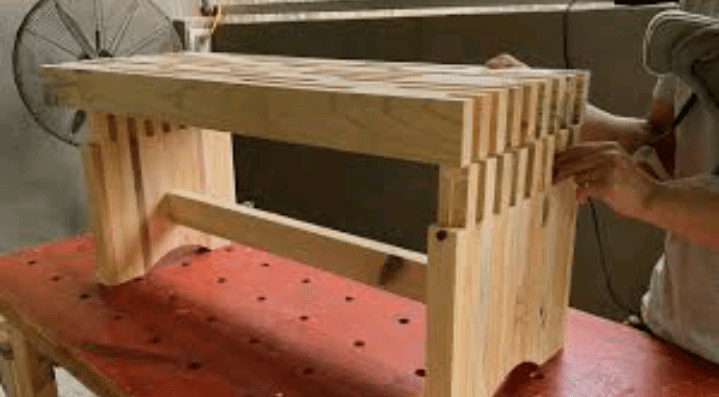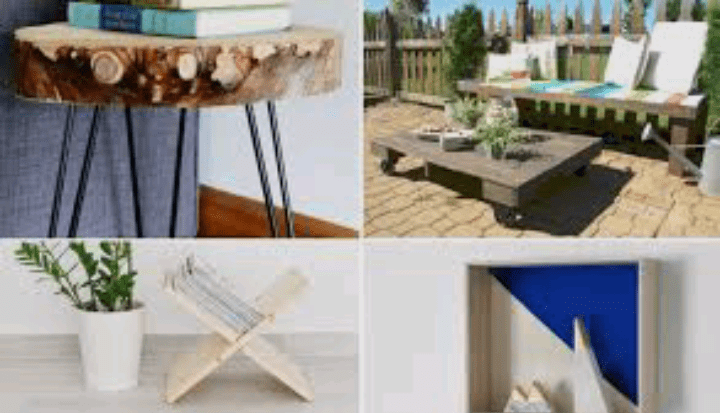Embarking on the world of DIY wood projects is an exciting journey that invites everyone, from the curious novice to the seasoned craftsman, to unleash their creativity with the timeless medium of timber.
Woodworking, once a traditional craft reserved for skilled artisans, has found new life in the hands of modern DIY enthusiasts. This article serves as your friendly guide, simplifying the art and craft of working with wood.
Whether you’re looking to spruce up your living space, delve into a fulfilling hobby, or simply add a personal touch to your surroundings, DIY wood projects offer a satisfying and approachable avenue for self-expression. From the basics of tool selection and wood types to the intricacies of joinery and finishing, we’ll walk through the essential steps, providing insights and relatable examples along the way.
Woodworking is more than just assembling pieces of timber; it’s an opportunity to learn, create, and bring your ideas to life. In the following sections, we’ll explore projects suited for every skill level, offering a hands-on experience that ranges from crafting simple bookends to the challenge of building a handcrafted bed frame.
So, whether you’re a weekend warrior or a weekday DIYer, let’s go into the world of DIY wood projects, where the beauty of craftsmanship meets the joy of making.
Read also: DIY Face Masks: Unveiling the Art of Crafting Natural Skincare Solutions
DIY Wood Projects

1. Getting Started with DIY Woodworking:
A. Essential Tools for the DIY Woodworker:
Before diving into the world of DIY wood projects, it’s essential to gather the right tools for the job. Basic tools like a saw, chisel, hammer, measuring tape, and screwdriver are fundamental for any woodworking project. As you progress, consider adding power tools such as a drill, jigsaw, and sander to your arsenal. Remember, investing in quality tools is an investment in the longevity and precision of your creations.
B. Selecting the Right Wood:
Wood selection is a crucial aspect of any woodworking project. The type of wood you choose can greatly influence the appearance, durability, and ease of working with the material. Softwoods like pine are ideal for beginners due to their affordability and ease of manipulation, while hardwoods like oak and mahogany offer a more refined finish but may require advanced skills.
C. Safety First:
Safety is paramount in woodworking. Always wear appropriate safety gear, including safety glasses, ear protection, and a dust mask. Familiarize yourself with the proper usage of each tool, and take the time to understand the fundamentals of woodworking safety. A well-prepared workspace minimizes the risk of accidents and ensures a smooth and enjoyable crafting experience.
2. Beginner-Friendly DIY Wood Projects:
A. Wooden Bookends:
For those just starting, crafting wooden bookends is a fantastic beginner project. With a simple design, this project introduces basic woodworking techniques such as measuring, cutting, and sanding. Choose a visually appealing wood and experiment with finishes like staining or painting to personalize your bookends.
B. Rustic Wooden Coasters:
Wooden coasters make for a functional and stylish project. Use small offcuts of wood to create these charming accessories. Sand the edges for a smooth finish, and consider adding a protective sealant to guard against moisture and enhance the wood’s natural beauty.
C. Wall-Mounted Key Holder:
Solve the perennial problem of misplaced keys by crafting a wall-mounted key holder. This project introduces the concept of assembling wooden pieces and can be customized to suit your home’s aesthetic. Experiment with hooks, shelves, and different wood finishes to create a practical and visually appealing organizational solution.
Read also: Mrcool DIY: Unleashing Your Creative Potential Through Do-It-Yourself Projects
3. Intermediate DIY Wood Projects:
A. Wooden Plant Stand:
Elevate your indoor greenery with a DIY wooden plant stand. This project delves into more advanced techniques like joinery and precision cutting. Experiment with different heights and designs to complement your home decor. Consider using hardwoods for a more polished look and enhanced durability.
B. Adirondack Chair:
Challenge yourself with the classic Adirondack chair. This project combines various woodworking skills, including angled cuts, assembly, and finishing. The end result is a comfortable and inviting outdoor chair perfect for lounging on lazy afternoons. Customize the design and paint or stain the chair to match your outdoor space.
C. Wooden Wine Rack:
Enhance your entertaining space with a handmade wooden wine rack. This project introduces the concept of creating modular components for assembly. Experiment with different wood types, and customize the size and configuration to accommodate your wine collection. Add a personal touch with unique finishes like distressed paint or a natural wood stain.
4. Advanced DIY Wood Projects:
A. Floating Wooden Shelves:
Elevate your living space with the sophistication of floating wooden shelves. This advanced project involves precision cutting, intricate joinery, and careful installation. Experiment with various wood grains and finishes to create a statement piece that seamlessly integrates with your home decor.
B. Wooden Coffee Table with Storage:
Combine form and function by crafting a wooden coffee table with built-in storage. This project challenges woodworkers with complex joinery and detailed construction. Customize the size, shape, and storage compartments to suit your needs, and finish with a stain or varnish to enhance the wood’s natural beauty.
C. Handcrafted Wooden Bed Frame:
For the ultimate woodworking challenge, consider crafting a handcrafted wooden bed frame. This ambitious project involves intricate joinery, precise measurements, and careful assembly. Experiment with headboard designs, wood types, and finishes to create a one-of-a-kind centerpiece for your bedroom.
5. Tips and Tricks for Successful DIY Woodworking:
A. Measure Twice, Cut Once:
The age-old adage holds true in woodworking. Accurate measurements are the foundation of any successful project. Take the time to double-check your measurements before making any cuts to avoid costly mistakes and wasted materials.
B. Embrace Mistakes as Learning Opportunities:
Woodworking is a skill that improves with practice. Don’t be discouraged by mistakes; instead, view them as valuable learning opportunities. Analyze what went wrong, adjust your approach, and use each project as a stepping stone to refine your skills.
C. Invest in Quality Materials:
While it can be tempting to cut costs on materials, investing in high-quality wood pays dividends in the longevity and aesthetic appeal of your creations. Quality materials are easier to work with, provide a more refined finish, and contribute to the overall durability of your projects.
D. Experiment with Finishes:
The finish applied to your woodworking projects can dramatically alter their appearance. Experiment with different finishes, such as stains, paints, varnishes, and oils, to achieve the desired look. Consider the wood’s natural characteristics and your project’s intended purpose when selecting a finish.
E. Join Woodworking Communities:
Connect with fellow woodworkers by joining online forums, attending local woodworking clubs, or participating in workshops. The exchange of ideas, tips, and experiences can enrich your woodworking journey and provide valuable insights into techniques and tools.
Read also: The Art of Waste to Jewelry Business
